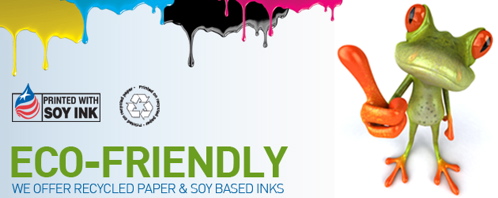 In my first post on “green” marketing, someone posted a comment about a company called Smart Levels that prints on recycled paper with soy-based inks. This piqued my interest, so I went and checked out the company’s website. Sure enough, there it was—the company’s proud declaration on its home page.
In my first post on “green” marketing, someone posted a comment about a company called Smart Levels that prints on recycled paper with soy-based inks. This piqued my interest, so I went and checked out the company’s website. Sure enough, there it was—the company’s proud declaration on its home page.
(Gotta love the tree frog, too. I’m a sucker for tree frogs.)
I think it’s terrific that more and more printing companies are moving toward environmental sustainability. It’s also terrific that marketers are increasingly caring about environmental sustainability—to the point that printers see investing in and promoting it as an effective strategy.
What caught my eye on Smart Levels’ home page, however, was not what was there but what was not. There were no other links to further efforts toward environmental sustainability. This might lead one to the conclusion that, by itself, printing on recycled stocks and using soy inks is enough.
But is it?
What Else Is in My Paper?
In reality, while recycled content and soy inks are a great start, there is much more you can do. Let’s just consider the paper. For example, have you ever asked the question, “Beyond recycled content, what else in my paper?”
There are many components that impact the greenness of paper beyond recycled content, including:
- Post-consumer waste (PCW) percentage. This is paper that has been used by the consumer (direct mail, office paper, newspaper) and returned for recycling, thus keeping it out of a landfill.
- Elemental and process chlorine-free. Chlorination in the papermaking process produces toxic chemicals collectively called “dioxins.” These toxic chemicals find their way into the papermaking effluent and, ultimately, into rivers and streams.
- Formulation of finishes or coatings (waterless, solvent, UV). Solvent-based coatings release harmful volatile organic compounds (VOCs) into the atmosphere. By switching to aqueous coating, you reduce your contribution to VOC emissions.
- Paper’s brightness. The lignin used to make paper is inherently on the yellow side. To create a white paper, that lignin must be bleached. The higher the brightness, the more chemicals that must be used to whiten it.
So when you are looking at claims to environmental responsibility based on recycled content (or other things), look beyond the surface. There is often much more you can do—you just have to ask the right questions.
Want to read more articles like this? Try these:




